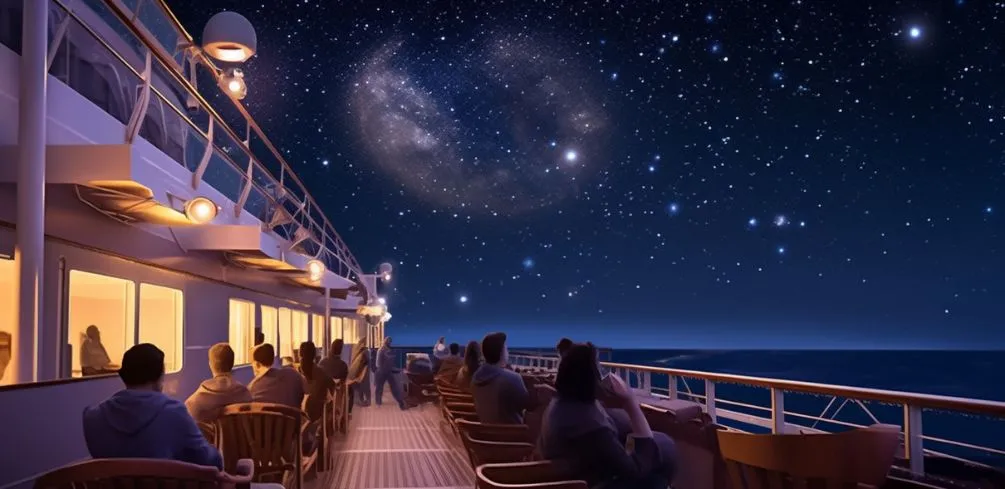Imagine sailing across the vast ocean, with an endless tapestry of stars above you, twinkling like diamonds in the night sky. Stargazing on a cruise offers an unparalleled opportunity to marvel at the celestial wonders and immerse yourself in the beauty of our universe.
With less light pollution and a unique vantage point far from land, your stargazing experience aboard a cruise ship will be nothing short of magical.
But before you embark on this enchanting journey through the cosmos, there are a few key things you need to know to make your stargazing adventure truly memorable.
This article will provide you with five essential tips for observing stars while cruising:
- Selecting the ideal time for star observation
- Choosing the best location on the ship
- Familiarizing yourself with constellations
- Essential stargazing equipment
- Utilizing mobile apps for an enhanced astronomy experience.
So grab your telescope (or binoculars), sit back, and get ready to explore the heavens as never before!
1. Selecting the Ideal Time for Star Observation
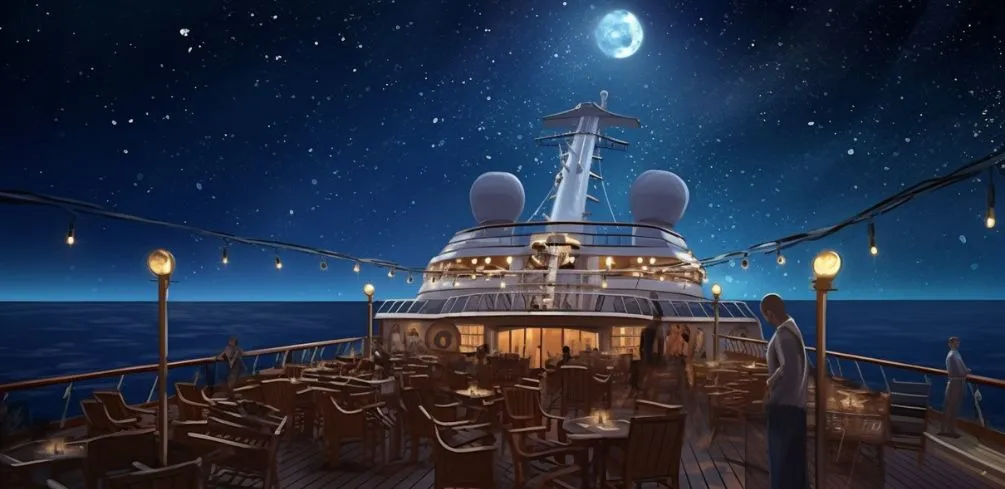
Picking the perfect moment to gaze at the stars can truly elevate your cruise experience. To ensure you have the best opportunity for optimal stargazing, consider factors such as moon phases, weather conditions, and zodiacal light.
Ideally, you’ll want to plan your observation during a new moon or when the moon is below the horizon; this will minimize interference from its brightness. Clear skies are also essential for unobstructed views of constellations and celestial events, so be sure to check weather forecasts in advance.
Another aspect to take into account when planning your stargazing session on a cruise is light pollution. Although being out at sea generally provides darker skies than city locations, some areas of the ship may still emit significant amounts of artificial light that can hinder your view of fainter stars and galaxies.
Try finding a spot away from brightly lit areas on board or ask if there are designated stargazing locations on the ship.
Additionally, be aware of any potential zodiacal light – a faint glow caused by sunlight reflecting off dust particles along Earth’s orbital plane – that might impact your viewing experience.
Timing your star observation with meteor showers can add an extra layer of excitement to your cruise adventure. Meteor showers happen when Earth passes through debris left behind by comets or asteroids, resulting in multiple shooting stars streaking across the night sky within a short period.
Research upcoming meteor showers and their peak dates so you can align your cruise itinerary accordingly for an unforgettable celestial spectacle while sailing through serene waters under a canopy of shimmering stars above you.
2. Choosing the Best Location on the Ship
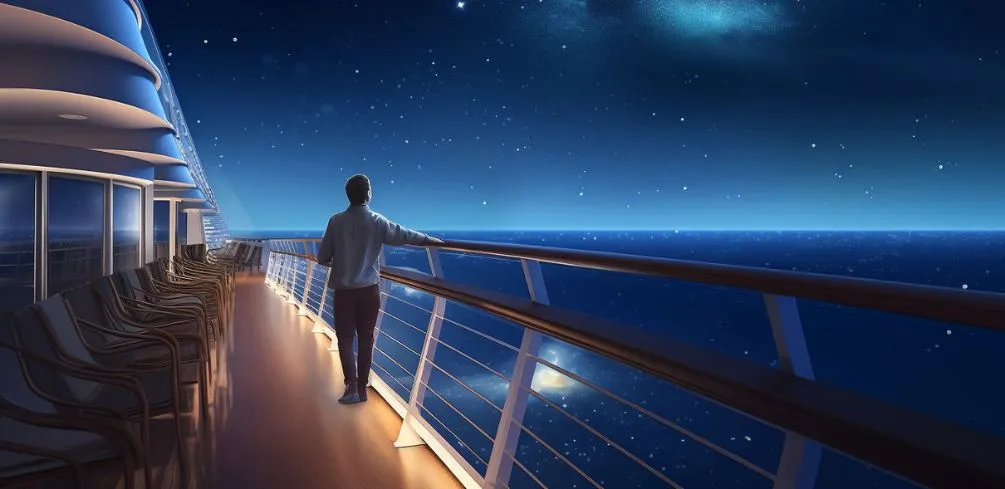
Finding the perfect spot to gaze at the stars on a ship can be as easy as pie, but it’s essential to consider a few factors for an out-of-this-world experience.
Ship deck positioning, unobstructed views, and avoiding light pollution are crucial elements in choosing the best location on the ship for stargazing. Additionally, cruise itinerary considerations and opting for stargazing friendly cruises will further enhance your celestial spectacle.
The first step in finding that prime star-viewing location is selecting a spot with minimal light pollution. Look for areas of the ship that have little or no artificial lighting – this often means venturing away from popular entertainment venues and pool areas.
Upper decks usually offer better opportunities for darker conditions and unobstructed views of the sky. Remember that you may need to move around during your cruise depending on which side of the ship offers clearer skies based on weather patterns and route direction.
Don’t forget to account for any stops along your journey – some ports might provide excellent stargazing opportunities if they’re situated far from city lights.
Lastly, remember that not all cruises are created equal when it comes to stargazing potential.
Before booking your voyage, thoroughly research each cruise line’s itinerary and what they offer regarding nighttime activities or onboard observatories tailored specifically toward star enthusiasts like yourself!
Some lines even partner with astronomy organizations or offer expert-led lectures and guided observations during their voyages – these options are ideal for those who want an immersive educational experience while enjoying breathtaking nightscapes above them.
By taking these factors into account when selecting both your cruise and the ideal location aboard the vessel, you’ll ensure a truly unforgettable stargazing adventure at sea!
3. Familiarizing Yourself with Constellations

Ready to level up your cosmic experience at sea? Let’s dive into the mesmerizing world of constellations and discover how to spot them like a pro!
Familiarizing yourself with constellations not only enhances your stargazing experience but also allows you to explore celestial navigation as ancient sailors did. To begin, learn some basic mythological stories behind famous constellations such as Orion, Cassiopeia, and Ursa Major.
These tales will help you remember the star patterns and add an enchanting element to your cruise nights.
When exploring the night sky, apart from locating constellations, identifying planets is another exciting aspect of stargazing. Planets usually appear brighter than stars and don’t twinkle, making them easier to distinguish.
Moreover, certain smartphone apps can help you identify visible planets and track their movement throughout the night.
While on a cruise ship, don’t forget that meteor shower spotting can turn any ordinary evening into a magical event! Research upcoming meteor showers before embarking on your journey so that you’re prepared for these captivating celestial performances.
As you delve deeper into stargazing during your cruise vacation, it’s crucial to be aware of light pollution impact on visibility. Cruise ships may produce considerable light pollution. Therefore, finding darker areas on deck or by the railings away from artificial lights will provide better viewing conditions for observing fainter celestial objects.
The further away from city lights and other sources of light pollution you are while at sea, the more stars become visible—allowing you to appreciate the true beauty of our universe in all its glory. So grab your binoculars or telescope, find a dark corner onboard with minimal light interference, and lose yourself in the wonders above!
4. Essential Stargazing Equipment
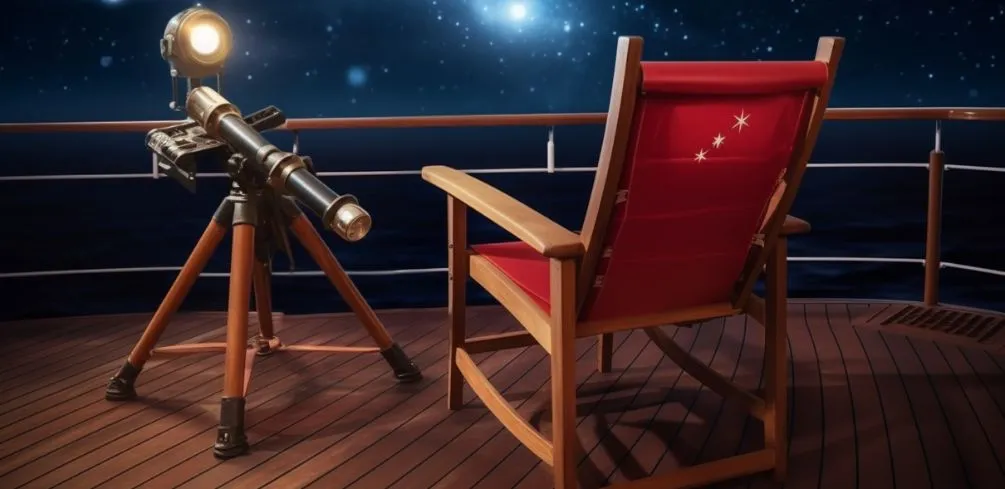
Embarking on a celestial adventure at sea? Equip yourself with the right gear and transform those enchanted nights into unforgettable memories.
While stargazing on a cruise, you’ll need some essential equipment to fully appreciate the beauty of the night sky. Some key items include binoculars, telescopes, tripods, red flashlights, and protective gear.
Binocular advantages are numerous when it comes to stargazing. They’re portable, easy to use, and provide an excellent introduction to observing celestial objects without investing in a telescope. When selecting binoculars for stargazing, look for ones with larger lenses (50mm or more) and a magnification of 7x or 10x.
Telescope options vary depending on your level of expertise and budget; popular choices include refractor and reflector telescopes. A tripod is necessary for both binoculars and telescopes as it provides crucial stability when observing celestial bodies – especially aboard a moving ship where vibrations can cause blurry images.
To preserve your night vision while navigating in the dark or reading star charts, make use of a red flashlight; its dim light won’t affect your ability to see faint stars.
Protective gear essentials like warm clothing and sturdy shoes should not be overlooked during your stargazing sessions on a cruise. Temperatures can drop significantly at night out on the open ocean; wearing layers will help keep you comfortable as you soak in the wonders above.
Moreover, cruise decks can be slippery due to moisture from sea spray or dew buildup; proper footwear ensures stability while moving around during observation sessions.
Armed with these essential tools and accessories in hand, you’re all set for an extraordinary stargazing experience aboard your cruise ship – one that will linger long after you return home!
5. Utilizing Mobile Apps for Enhanced Astronomy Experience
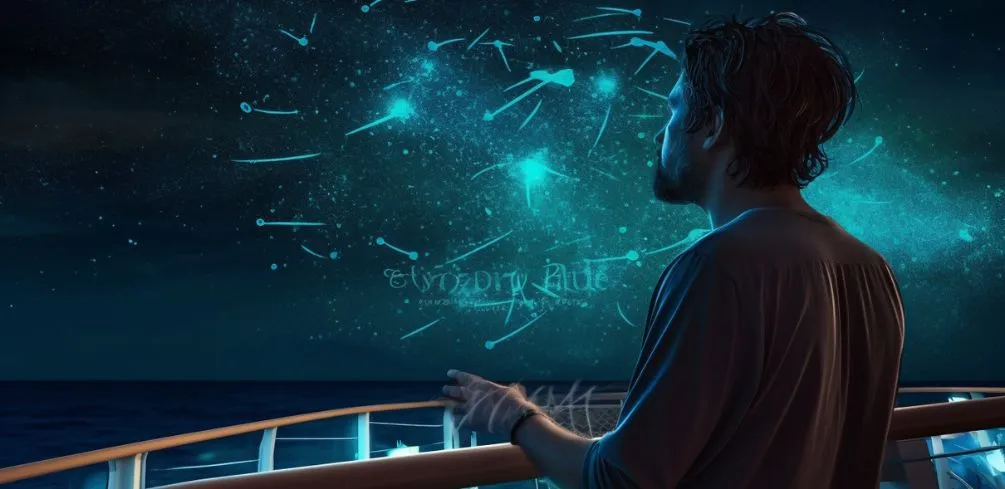
There’s no denying that harnessing the power of mobile apps can truly elevate your astronomy experience, making those starlit nights aboard your cruise even more magical and awe-inspiring.
With app navigation tips at your fingertips, you’ll be able to identify constellations, stars, and planets with ease. Make sure to select an app that is compatible with your smartphone or tablet for seamless integration.
Many stargazing apps offer offline functionality so you won’t have to worry about internet access while cruising in remote areas. Make sure yours is in this classification before embarking as fees can get very expensive on a cruise.
Furthermore, augmented reality features provide a unique way to explore the night sky by overlaying celestial information on real-time camera views.
To ensure an engaging experience without any hiccups, it’s important to take some app safety precautions before embarking on your cruise. Begin by downloading and familiarizing yourself with the chosen app while still connected to a reliable internet connection – this will enable you to download any necessary data or updates required for optimal performance during your trip.
Additionally, make sure your device is equipped with a screen dimming feature or red-light filter, which helps preserve night vision as well as minimizes light pollution that could disrupt fellow stargazers.
As you set sail under the vast expanse of the open skies, using mobile apps for enhanced astronomy experiences adds an extra layer of excitement and discovery during those unforgettable evenings aboard a cruise ship.
By staying informed about smartphone compatibility, utilizing offline functionality options, and taking advantage of augmented reality features in these cutting-edge applications, you’ll transform each starry night into an immersive learning adventure.
Just remember always to prioritize app safety precautions in order not only to preserve the serenity of the nighttime environment but also to maintain harmony among fellow cruisers sharing this remarkable journey through our wondrous cosmos.
Capturing the Night Sky with Photography
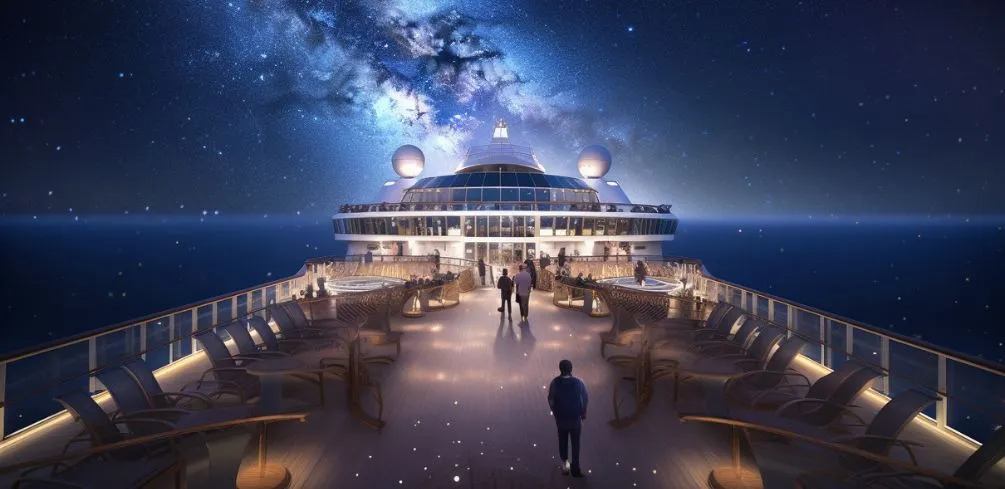
Capturing stunning images of the night sky while on your cruise is a fantastic way to immortalize those breathtaking celestial moments. To ensure your photos are as impressive as the views you’re witnessing, it’s essential to use the right gear and techniques.
Start with selecting an appropriate nighttime lens for your camera, usually one with a wide aperture (f/2.8 or lower) to allow more light into the sensor.
A tripod is also crucial for stabilizing your camera during long exposures; this will prevent shaky images and ensure crisp, clear shots of the stars above.
When setting up your camera, pay close attention to its settings since capturing stars requires different adjustments compared to regular photography. Begin by using manual mode so that you have full control over shutter speed, aperture, and ISO settings.
For long exposure tips, try starting with a shutter speed of 20-30 seconds – although you may need to experiment depending on how dark the sky is at your location. Set your aperture as low as possible (e.g., f/2.8) and choose an ISO between 1600 and 3200 to balance image brightness without introducing too much noise.
After taking several shots of the night sky during your cruise, don’t forget about post-processing in order to bring out the best in your images. Editing techniques like adjusting contrast, highlights, shadows, and white balance can make all the difference in turning a good photo into an awe-inspiring one.
Noise reduction tools can help eliminate any graininess caused by high ISO settings during capture without sacrificing detail or sharpness in your final image.
By employing these methods along with careful consideration of composition when framing each shot, you’ll be well on your way towards creating unforgettable photographs of star-studded skies experienced aboard a cruise ship journey that will surely impress friends and family alike!
Conclusion
So, you thought stargazing on a cruise would be a walk in the park, huh? Well, now you know it’s more than just stepping out on deck and looking up.
But armed with these tips – from timing and location to gear and apps – you’re ready to conquer the night sky like an astronomical pro.
Go ahead, impress your fellow cruisers with your celestial knowledge. After all, now you’ve got the stars at your fingertips – or should we say, eyepiece?

